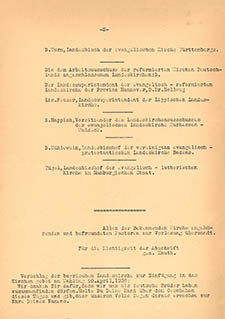The Austrian “Anschluss”
Hitler had Wehrmacht troops and police units march into the Republic of Austria on March 12, 1938. He signed the “Law on the Reunification of Austria with the German Reich” on the following day.
A plebiscite, in which the populace was supposed to approve of the “Anschluss” after the fact, was held on April 10, 1938. The ballots contained only one sentence: Do you approve of the reunification of Austria with the German Reich enacted on March 13 and do you vote for our Führer Adolf Hitler’s list of candidates? Over 99 percent in Germany and Austria voted their approval.
The Austrian “Anschluss” sparked national euphoria in the populace, which also seized the Protestant church. Its German Christian President Friedrich Werner immediately sent a telegram for the German Evangelical Church to Hitler, which stated that the church looks to God full of thanks and implores his blessing for the Führer and his work in the future, too.
In an Appeal to Vote in the Plebiscite on April 10, 1938, Werner declared the Protestant church’s unity in the Yes to greater Germany and to the Führer’s deed and called for every Protestant German do his duty willingly and thankfully on April 10.
Similar messages of endorsement and statements of political loyalty to Hitler also came from church leaders who were not German Christians and from regional churches affiliated with the moderate Confessing Church.
On March 16, 1938, the Evangelical High Consistory in Stuttgart instructed that an address be delivered and a hymn of thanksgiving be sung in the church services on the following Sunday. The draft address referred to the Anschluss as the Führer’s act of liberation through which the fetters in which the German and the Austrian people had once been placed by the peace diktat had been smashed link by link.
Despite the Nazi state’s increasing reprisals against the church and the state’s violent measures against pastors and congregational members, church officials explicitly declared themselves in favor of a Yes in the plebiscite on April 10, 1938.
Even the “Council of the Evangelical Lutheran Church in Germany”, the governing body of the moderate Confessing Church, announced in a message to congregations in the run-up to the plebiscite: On the coming Sunday we will unite with all Germans in order to express our loyalty to the newly created Greater German Reich and its Führer.
Source / title
- ©Ev. Arbeitsgemeinschaft für Kirchliche Zeitgeschichte München, C 3. 23


